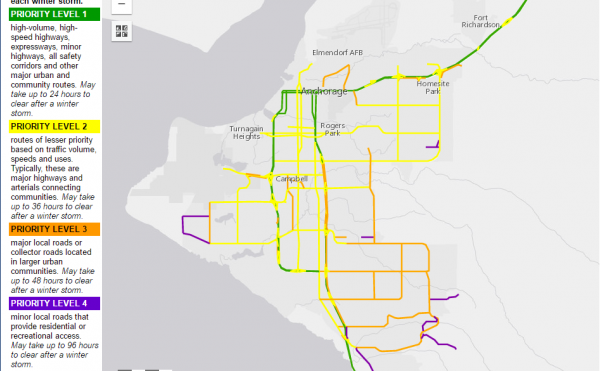
Officials in Anchorage are considering a change to snow plow policies after a “flood” of complaints in the last few weeks. Responsibility for clearing many of the city’s biggest and busiest roads after a snow storm is shared between the municipality and the state. But city leaders say state budget cuts have left a mess that may require rethinking a decades-old arrangement.
Assembly members in Anchorage are accustomed to constituents calling about unplowed roads. But this year has been special.
Forrest Dunbar represents the east side of town, and said the majority of messages and calls he gets from constituents are about major roadways like Muldoon and Tudor that are supposed to be handled by state maintenance crews. More alarming was who he heard from after last weekend’s snowstorm.
“Just recently I had some medical professionals reach out to me and say that they’re seeing a tremendous amount of injuries come into the ER’s from crashes,” Dunbar said in an interview. “A lot of those crashes happen on the bigger, faster state roads that aren’t being properly maintained.”
The claim that poorly plowed roads are leading to more accidents is tricky to prove.
Area hospitals don’t track the cause of all the injuries that come through emergency rooms, so there’s no readily accessible way to quantify how many admissions came from car crashes in a given period. Data from the Anchorage Police Department shows a high number of accidents and distressed vehicles during recent heavy snow storms, much of it concentrated around the major roads under state jurisdiction. But those tend to be the roads that see the highest traffic in general, where the majority accidents occur throughout the year. And people simply crash their cars more when there’s bad weather, so police and officials are hesitant to point to snow plow policy as the culprit.
But there most definitely is a drop in the state’s ability to clear the roads. Shannon McCarthy is the spokesperson for the Department of Transportation’s central region, which is in charge of Anchorage.
“This is the new normal,” McCarthy said
DOT’s budget for snow plowing has dropped 16 percent over the last two years, according to McCarthy. That translates to a loss of 15 positions in the Southcentral region, along with less heavy equipment.
“People have noticed that we haven’t been able to respond as quickly as we have in the past,” McCarthy said.
The cuts have been incremental, and particularly hard to notice given the last two mild winters for the region. But this year’s back-to-back storms are straining resources.
McCarthy said budget reductions have limited the amount of overtime pay the Department has on hand, prompting them to save it for the most serious events. There are also fewer people to call in for those overtime shifts.
“We lack the capacity fluctuate that workforce upward,” McCarthy said.
When it snows, the state prioritizes clearing the Glenn and Seward highways, as well as Minnesota Boulevard. The next tier of roads are the ones within the Anchorage Bowl that are interspersed throughout many of the densest residential areas: Abbott, Huffman, Tudor, Muldoon, A and C street, along with sections of Northern Lights and Benson. The state’s plan calls for those to be plowed within 36 hours of when a storm stops.
The current arrangement called the Transfer of Responsibility Agreement (TORA), which been updated and adjusted in pieces since it was signed in 1991.
“Looking at the map now, it’s really hard to understand the rational of state ownership over one road versus (municipal) ownership of another,” City Manager Mike Abbot said.
An updated TORA was signed in the last few weeks, according to Abbott.
Like the state, the city is trying to handle the same workload but with less resources, having trimmed money for road maintenance in its own 2017 budget. But Anchorage officials insist recent problems are disproportionately arising from the state’s side. The issue is prompting the city to look at taking over plowing responsibilities for some of the most crucial traffic corridors.
“It has become a little lop-sided, and as a result of that the mayor has directed me to begin a conversation with the state that would find some way to try to unify winter maintenance,” Abbott said.
He and others admit discussions over unification are still in a very early stage, and there are no details yet on how millions of dollars in state and municipal funds would be reorganized.
Mayor Berkowitz has been criticized by conservatives after remarks last week that some say framed plowing as a financial choice between maintenance and public safety. Myer Hutchinson, communications director for the mayor, said the remarks have been grossly mischaracterized, and that city services have never been presented as one-for-one trade offs.
Correction: An earlier version of this story stated there’s no way for hospitals to track “traumatic” injuries. Trauma cases are a distinct class of injury, and are reported to the state. Minor injuries that don’t require inpatient care are not counted the same way.
Zachariah Hughes reports on city & state politics, arts & culture, drugs, and military affairs in Anchorage and South Central Alaska.
@ZachHughesAK About Zachariah




